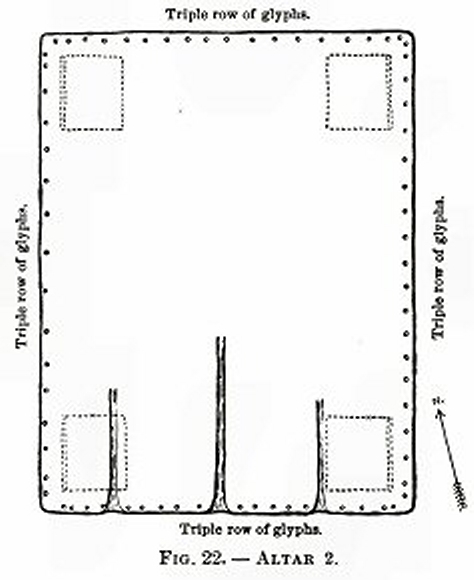Archived Articles
by
Norman Scherer
THC subscriber
Introduction
Out of the thousands of readings channeled by Edgar Cayce, reading 440-5, a life reading, is one of the most interesting. Channeled on December 20th, 1933, it gives a description of a giant crystal on Atlantis that was, apparently, at one time, its main power source, among many other uses it had throughout the long history of Atlantis. This crystal is also called a "firestone" and in another reading, it is named the Tuaoi stone. This firestone, could concentrate the energy emanating from the sun and other stars, combine this energy with other elements, store it, and use it, when needed, to propel vehicles in all modes of travel by some sort of induction method or remote control. The rays that were emitted by this firestone were invisible and propelled vehicles through the air, on the water and even under water. Mr. 440, was one of the few "initiates" who directed the "influences of the radiation". This firestone not only provided power, but it also accomplished other things,
Through the same form of fire, the bodies of individuals were regenerated, by the burning - through the application of the rays from the stone, the influences that brought destructive forces to an animal organism. Hence the body rejuvenated itself often, and remained in that land until the eventual destruction, joining with the peoples that made for the breaking up of the land - or joining with Baalilal at the final destruction of the land.
In reading 519-1 we also find that,
...as to the manner and ways in which the various crafts carried individuals form place to place, and what may be known in the present as the photographing from a distance, or the fields of activity that showed the ability for reading inscriptions through walls - even at distances, or for the preparations of the elevations in the various activities where there was the overcoming of (termed today) the forces of nature or gravity itself; and the preparations through the crystal, the mighty, the terrible crystal that made for the active principle in these, were a portion of the activity of the entity in that experience. Much of it brought destruction;
As one can see, this firestone did about everything. Not surprisingly, plans were made that indicated how to construct this firestone. Because these construction plans were of such great importance at that time in history, an effort was made to preserve them and to locate copies to safer locations outside the realm of the catastrophe that was unfolding on what was left of Atlantis circa 10,600BC.
Construction Plans
Reading 440-5 also describes, in a general way, the
As to describing the manner of construction of the stone, we find it was a large cylindrical glass (as would be termed today), cut with facets in such a manner that the capstone on top of same, made for the centralizing of the power or force, that concentrated between the end of the cylinder and the capstone itself.
Construction plans of the firestone were taken to various locations, one of which was Yucatán:
As indicated, the records of the manners of construction of same are in three places in the earth, as it stands today: In the sunken portions of Atlantis, or Poseidia, where a portion of the temples may yet be discovered, under the slime of ages of seawater - near what is known as Bimini, off the coast of Florida. And in the temple records that were in Egypt, where the entity later acted in cooperation with others in preserving the records that came from the land where these had been kept. Also the records that were carried to what is now Yucatán in America, where these stones (that they know so little about) are now - during the last few months - BEING uncovered.
It is interesting to note that, of all the places where the construction plans were taken, only two, Yucatán and Egypt, are on dry land. With the firestone being "the active principle" in "overcoming...gravity itself" is it any wonder that some of the world's largest pyramids and other huge monuments are located in these two areas?
These Stones are an Emblem
The focus of this article, will be the lines in the excerpt above that are highlighted in bold face. The first thing we have to determine, from this excerpt, is what exactly is Cayce's source referring to when it says, "...where these stones (that they know so little about) are now....BEING uncovered"? Since the paragraph started out explaining where the "records of the manners of construction" of the firestone were located, do "these stones....being uncovered" refer to actual firestones? Or to the records "that were carried to what is now Yucatán"? Or something else? As we pick up the text of the reading again, it is apparent that the subject of this reading, known as Mr. 440, believes that the actual firestones are being uncovered:
Also the records that were carried to what is now Yucatán in America, where these stones (that they know so little about) are now - during the last few months - BEING uncovered.
Ready for questions.
(Q) Is it for this entity to again learn the use of these stones?
(A) When there have come those individuals who will purify themselves in the manner necessary for the gaining of the knowledge and the entering into the chambers where these may be found; yes - if the body will purify itself. In '38 it should come about, should the entity - or others may - be raised.
From the way the question was phrased (implying that the stones being uncovered, would have an actual use) it is my contention that the source Cayce was channeling, answered this question without regard for the phrase "...where these stones....are now....BEING uncovered". Rather, the question was answered honestly as to what Mr. 440 would have to do to learn how to use a firestone again, (purify yourself in the manner necessary so you can gain the knowledge and enter into the chambers where they are located). At that point, a clarification ensues which seems to point to the fact that only an emblem of a firestone (as opposed to a firestone one could actually use) is being uncovered in Yucatán.
In Yucatán there is the emblem of same. Let's clarify this, for it may be the more easily found....
What I believe the source is trying to convey is that no actual firestones were being uncovered in Yucatán, only an emblem of the firestone was being uncovered. Indeed, why would one need to purify oneself to use an emblem, which has no practical use? Why would one need to "gain knowledge" to use what is essentially a symbol? I believe Mr. 440 misunderstood what was being uncovered in Yucatán, asked an innocent question based on this misunderstanding, and then Cayce's source tried to answer this question, but then attempted to clarify what was really being uncovered: only an emblem, not a firestone. To summarize the quote to what I really think is being conveyed it would sound like this:
In Yucatán there is an emblem of the firestone, that is in the last few months being uncovered. Let's clarify this, so the emblem may be more easily found.....
Further support for my contention that only an emblem of the firestone, and nothing else, was being uncovered in 1933, can be found as we pick up the narrative again, where we left off:
In Yucatán, there is the emblem of same. Let's clarify this, for it may be the more easily found - for they will be brought to this America, these United States. A portion is to be carried, as we find, to the Pennsylvania State Museum. A portion is to be carried to the Washington preservations of such findings, or to Chicago.
The stones that are set in the front of the temple, between the service temple and the outer court temple.....
So how does this quote support my belief that only the location of the firestone emblem was given? If you will notice, the location of the stone's emblem is "in the front of the temple, between the service temple and the outer court temple". In other words it's outside. When Mr. 440 asks, if he is to "learn the use of these stones" being uncovered (thinking they were actual firestones, not emblems), he is told that he must purify himself for about 5 years [in '38 it should come about], then he will gain the knowledge for the entering into the chambers where these may be found. In other words the firestones themselves are located in chambers somewhere. Where these chambers are, wasn't given. The emblem of the firestone, however, is located outside, in front of a temple in Yucatán. The two statements are mutually exclusive. It can't be "in front" of a temple and "in chambers" at the same time. Therefore, they must be talking about two different items.
I think it is also clear that the source is not referring to "the records that were carried to what is now Yucatán in America, where these stones...are now being uncovered." The "where" in the "where these stones" phrase, I believe, refers to Yucatán in general, not to the actual specific place in Yucatán where the records were taken and stored. This seems to be the contention of those that are searching for a "Lost Hall of Records" in Yucatán. They believe the location of the emblem, as described in 440-5, must be the same place where the records "that were carried to Yucatán" are located. This is purely a leap of faith and nothing more than an assumption that is not supported by what Reading 440-5 actually says.
Reading 5750-1, given just a few weeks prior to reading 440-5, states specifically that the temple in Yucatán, where the records were kept, was destroyed at the same time as the final sinking of Atlantis. This temple, built by Iltar and his group of followers, will rise again, sometime in the future, when certain conditions are met:
(Q) In which pyramid or temple are the records mentioned in the readings given through this channel on Atlantis, in April, 1932?
(A) As given, that temple was destroyed at the time there was the last destruction in Atlantis. Yet, as time draws nigh, when changes are to come about, there may be the opening of those three places where the records are one, to those that are the initiates in the knowledge of the One God: The temple by Iltar will then rise again. Also, there will be the opening of the temple or hall of records in Egypt, and those records that were put in the heart of the Atlantean land may also be found there - that have been kept, for those that are of that group. The RECORDS are ONE.
This clearly, without any doubt, shows that the records that were taken to Yucatán are in fact, located in Iltar's temple and that they are unavailable until the temple by Iltar rises again. When this temple rises, then and only then, can those records be opened. The words "as given" are highlighted in yellow because this indicates that the source had already given that information earlier. Where you ask? In the same reading:
...- in the varied portions of the land - which was much greater in extent until the final upheaval of Atlantis, or the islands that were later upheaved, when much of the contour of the land in Central America and Mexico was changed to that similar in outline to that which may be seen in the present.
The first temples that were erected by Iltar and his followers were destroyed at the period of change physically in the contours of the land. That now being found, and a portion already discovered that has laid in waste for many centuries, was then a combination of those peoples from Mu, Oz and Atlantis.
This proves, beyond any doubt, that any "lost hall of records" is not in the same location given for the firestone emblem. There is not even a mention anywhere in the readings of a "Hall of Records" in Yucatán, only a temple where the records were supposedly stored. When this temple by Iltar rises [it will rise again], THEN there may be the opening of those records. By whom? To those that are the initiates in the knowledge of the One God. This is not going to happen until the time is near (nigh) when the many earth changes detailed in the readings are to come about. All this could not occur in the 1930's, so the instructions that were given for the location of a firestone emblem, were just that, and nothing more.
Amazingly however, we find this statement in The Lost Hall of Records book,
Of course, the most important Cayce clue related to the 1933 expedition is that the Hall of Records is located near "where these stones (that they know so little about) are now during the last few months - BEING uncovered." 1
This statement is even more amazing when you consider that this is the main premise of the entire book.
Also, the statement at the end of the previous excerpt, which starts out with the phrase, "that now being found", could not refer to Iltar's temple either, because it hasn't risen yet, and won't rise until "time draws nigh when changes are to come about". "That now being found" does pertain to the excavations that were then going on in Yucatán, and classifies the discoveries as belonging to a mixture of people from the older Lemurian groups that were already living in Yucatán, and the more recent arrivals from Atlantis.
Where is the Emblem located?
As mentioned previously, the stones are outside, in front of a temple, between the service temple and outer court temple. What does this mean? We come then, to what I think, is the key phrase in the reading,
For later there arose (which may give a better idea of what is being meant) the activities of the Hebrews from this - in the altar that stood before the door of the tabernacle.
The key phrase is highlighted in yellow. What follows this phrase gives a better idea of where the emblem is located. The emblem is located in front of the temple, in the same location as the Hebrews located "the altar before the door of the tabernacle." This, then, gives one a better idea of what is being meant when Cayce's source describes the emblem as being in "front of the temple, between the service temple and the outer court temple."
Where is the altar before the door of the Tabernacle located? From A Brief Sketch of the Jewish Tabernacle (Pendleton, 1901) we find the following,
THE LAVER was made of the copper looking-glasses which belonged to the women. The size of it is not known, but as all sacrifices were washed there before being offered on the altar, it must have been quite large. The one made by Solomon was called "the molten sea," and was about 16 feet in diameter. Priests passing to and from the holy place and the altar were required to bathe their hands and feet at the laver under penalty of death, and the high priest on the day of atonement had to bathe his entire person there before entering the Holy of holies. The laver typified Christian baptism. As the laver stood at the door of the tabernacle, so baptism stands at the door of the church.
A typical layout for a Tabernacle might look something like this:
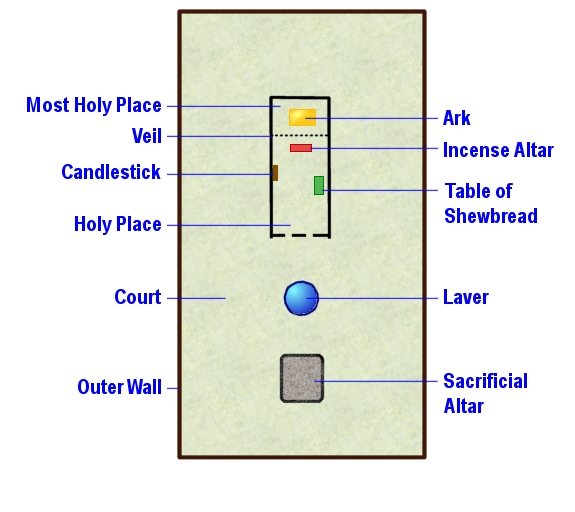
The firestone emblem would be in the same location as the laver. Notice how it is positioned as "the altar before the door of the tabernacle", which puts it in "front of the temple", between the service temple (Holy Place) and the outer court temple (the Brazen Altar) - or the "priest activity". What is the "priest activity"? From the quote above, we find that the priest activity mainly consisted of,
Priests passing to and from the holy place and the altar were required to bathe their hands and feet at the laver under penalty of death...
This altar or stone, then, in Yucatán, stands between the activities of the priest...
So how does this relate to Mayan ruins found in Yucatán? An example of what I think is being conveyed is found in Uxmal at the so-called Governor's Palace. In the courtyard (the outer court) are two altars. One is in the shape of a large cylindrical stone and is closest to the palace. The other, has a curious two-headed jaguar resting on it. The cylindrical stone would be in a similar position as the laver and the jaguar as the brazen altar. Some other perspectives of this arrangement can be found here.
This gives us then, an idea of the kind of arrangement we can look for once we've determined where we need to look. The cylindrical stone is in the same location as a laver would be, and where our emblem should be.
The Pennsylvania State Museum
In Yucatán, there is the emblem of same. Let's clarify this, for it may be the more easily found - for they will be brought to this America, these United States. A portion is to be carried, as we find, to the Pennsylvania State Museum. A portion is to be carried to the Washington preservations of such findings, or to Chicago.
(Q) Who is conducting this work in Yucatán?
(A) Would it be sent to any other place than to those who were carrying on same?
(Q) How many facets did the crystals previously referred to have?
(A) Would be better were these taken from the pattern of same that will be eventually put in the museum in Pennsylvania.
These three excerpts from reading 440-5 give us some useful information in trying to locate the firestone emblem. First it tells us where the emblem is going and who is conducting the "work in Yucatán". It also provides a hint of what the emblem looks like. The emblem is apparently some sort of "pattern" of the firestone to the point where the number of facets can be determined from it. Also, the excavation of this emblem is taking place where the Pennsylvania State Museum is currently excavating in Yucatán. That's the good news. The bad news is that the Pennsylvania State Museum never excavated in Yucatán. In fact, their mission in the 1930's was summarized as,
At the end of the 1930s, The State Museum linked its survival to the fulfillment of its mission: to collect, care for, and exhibit the flora and fauna, history, archaeology, and fine arts of the Commonwealth. It managed to fulfill its mission not just with state appropriations, but federal dollars as well.
-----from the State Museum of Pennsylvania: A Centennial History 1905-2005
This doesn't seem like the type of organization that would be exploring in Yucatán. In fact, things got so bad at this museum, that in 1933, the year Reading 440-5 was given, the museum almost closed:
Perhaps the most catastrophic effect of the Great Depression was in the area of personnel. In 1931 the State Museum had a staff of twelve—museum director, curator, assistant curator, exhibit preparer, taxidermist, three assistant taxidermists, two stenographers, lantern slide assistant, and general clerk. By 1933, at the depth of the Great Depression, the museum staff consisted of only three people: assistant director, curator, and exhibit preparator.
It's obvious this organization did not and could not, conduct any research in Yucatán at this time or at any other time because it had little money and it was also beyond the scope of its mission which was to collect, care for, and exhibit the flora and fauna, history, archaeology, and fine arts of the Commonwealth. There is some support however, in another reading given in this series, that alludes to the University of Pennsylvania being the organization conducting this work in Yucatán. In reading 440-12 given on January, 10, 1934 we read the following excerpt:
(Q) Do you think it is wise to write the Pennsylvania State Museum, or called University of Pennsylvania, telling them of the crystals they will uncover in Yucatán in order that later they may be interested in an expedition to Bimini?
(A) This would be well. Seek to find, through not divers [diverse] channels but through a regular channel from the university, as to who has led the expeditions in their recovering and restoration in part (for the better comprehension of that which took place) in Yucatán , and then communicate directly with that leader.
It seems clear from this exchange, that the University of Pennsylvania (UPenn) is the organization that was conducting the work in Yucatán. If UPenn was incorrect, one would think that the error would have been pointed out. Not only was it not corrected, but Mr. 440 was told to contact someone from the university to find out who led the expeditions. Also, this museum is popularly known as the Penn Museum which could be easily confused with the Pennsylvania State Museum.
It seems the source Cayce channeled did have a good idea as to what area in the US the expeditions in Yucatán came from, but was not so clear as to what organizations were backing the expeditions. We have the Pennsylvania State Museum error and also the source could not name the organizations from Washington or Chicago (A portion is to be carried to the Washington preservations of such findings, or to Chicago).
While we are discussing this excerpt, you will notice that the term "uncover" is better defined. In the question, it is asked, in part "....telling them of the crystals they will uncover in Yucatán...". In the reply we read,
...as to who has led the expeditions in their recovering and restoration in part (for the better comprehension of that which took place) in Yucatán....".
In other words, the term "uncovering" refers not only to digging out of the ground, but could also mean the recovery and restoration of the stones, (for the better comprehension of that which took place). This is an important point, because now the emblem does not necessarily have to be dug out of the ground, but just recovered and/or restored. This could mean, for example, that it might have been lying on the ground in pieces, and have to be put back together.
Piedras Negras
If we assume the University of Pennsylvania Museum is the correct organization, we can then ask, were they excavating in Yucatán in the 1930's? The answer is yes and no, depending on how you define Yucatán. From Wikipedia we find that,
Yucatán is the name of one of the 31 states of Mexico, located on the north of the Yucatán Peninsula. The term The Yucatán refers to the three states on the peninsula: Yucatán, Campeche, and Quintana Roo; all three modern states were formerly part of the larger historic state of Yucatán in the 19th century.
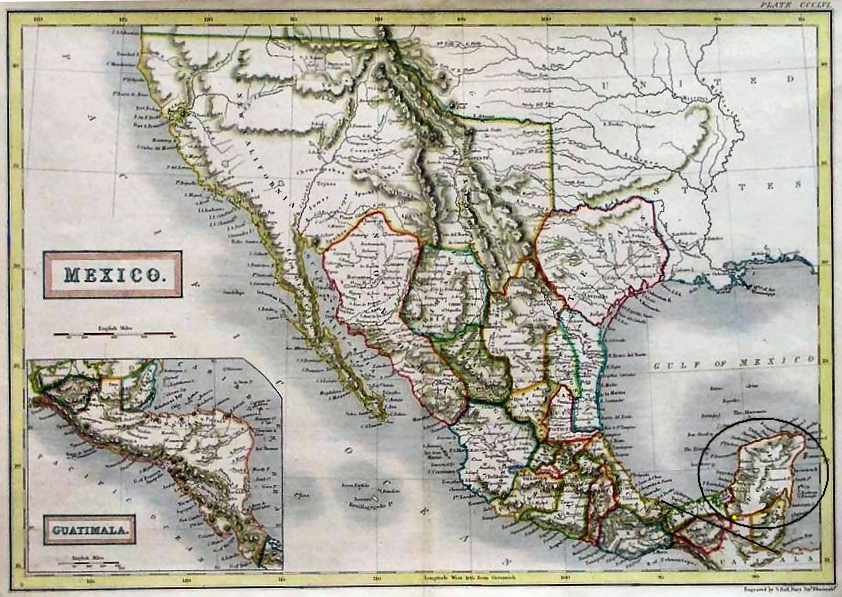
It is true, that if one were to ask an archaeologist where the University of Pennsylvania was excavating in the 1930's, he would not answer "in Yucatán". However, the information we are working with was psychically derived, and we can't really be sure with what level of accuracy the source was using. I believe, this source was using geographic terms in a very general way. Two examples support this point of view. If you'll notice, reading 440-5 inaccurately describes where Yucatán
.....Also the records that were carried to what is now Yucatán in America....
Obviously, Yucatán is not located "in America", as we commonly use the term, but in Mexico or more generally in Central America. So in this instance, the term "America" was substituted for the more accurate term "the Americas" or Central America. Then, when the USA is referred to, a different terminology is used again,
.....for they will be brought to this America, these United States......
Taking note of how interchangeably these geographic names are used in these two examples, I think it is reasonable not to put too stringent a definition on the term "Yucatán". Yucatán, in this reading anyway, probably refers to the entire Yucatán peninsula.
If we proceed with these two assumptions, that the University of Pennsylvania is the correct organization, and Yucatán refers to the general area of the Yucatán Peninsula, we can then start our own "digging" for the firestone emblem.
In 1930, the University of Pennsylvania Museum had decided to start excavating the Mayan site of Piedras Negras (PN) which is located on the Mexican-Guatemalan border. The Usumacinta River divides the two countries here, with PN being located on the Guatemalan side, a short distance from the river. A brief background summary of this expedition is provided by the Foundation for the Advancement of Mesoamerican Studies or FAMSI, on the Piedras Negras section of their website and I see no need to repeat it all here. They also have made available, many of the unpublished documents from those expeditions. These documents are a valuable resource in trying to determine what exactly was excavated at the Piedras Negras site and when it was excavated.
When was the Emblem Removed?
A good starting point to answering this question, might be to try and determine when the firestone emblem would have been removed and sent to Pennsylvania. This would help to eliminate those objects that were sent to Pennsylvania in the wrong timeframe. Many people (including this author), have always assumed that, since the stones were being "uncovered" in the months before reading 440-5 was given on December 20, 1933, that in all likelihood, that is the year the emblem was sent to Pennsylvania. A closer examination of readings 440-5 and 440-12 reveals that this is unlikely:
In Yucatán, there is the emblem of same. Let's clarify this, for it may be the more easily found - for they will be brought to this America, these United States. A portion is to be carried, as we find, to the Pennsylvania State Museum. A portion is to be carried to the Washington preservations of such findings, or to Chicago.
(Q) How many facets did the crystals previously referred to have?
(A) Would be better were these taken from the pattern of same that will be eventually put in the museum in Pennsylvania.
The use of the highlighted words seems to imply an event that will occur sometime in the future. Further support for this view is seen in reading 440-12 given on January 10, 1934:
(Q) Would you tell us more that may be uncovered, that we can tell him? [the leader of the expedition]
(A) Rather sufficient would it be that there be particular precaution in the uncovering of the stone or what may appear in the uncovering of what might be termed the sun dial....
So instead of telling him what other stones will be uncovered, Cayce's source tells Mr. 440 that it would be sufficient to just tell the leader of this expedition to use "particular precaution" in the uncovering of the stone. The stone, then, is still there and not recovered as of January 10, 1934. It might be useful to remember that excavations at that particular site, can only occur in the dry season, which usually runs from March to June. The rest of the time it rains more or less constantly and you cannot dig. Therefore, the next excavations would have occurred in the early spring of 1934. There was an expedition that year, but no monuments could be removed during the 1934 field season, because the museum had inadequate funds to pay for the required Guatemalan inspector's salary. So the earliest the expedition could have shipped the emblem back to Pennsylvania is 1935. Anything shipped to the museum in Pennsylvania before 1935 would have to be eliminated as an emblem candidate.
What does the emblem look like?
This firestone emblem is described in the various readings as "these stones" or "this altar or stone", a "sundial" and a "pattern of the firestone" where you could determine how many facets there were, although "erosion has had an effect" on it. The first descriptive
....This altar or stone, then, in Yucatán, stands between the activities of the priest....
Here the emblem is called an altar. Now there are many so-called altars found at the PN site. Some are small drum-like altars which are found all over the place. Some are in "ball courts", and others are in temples. There are also "column altars" that do indeed sit in front of structures (e.g. R-9) and would appear to be strong candidates as a firestone emblem. However, most of these are of the rather plain variety and are devoid of any markings. One must keep in mind that one of the qualifications mentioned in reading 440-5, is that it must contain a representation of the facets that were cut into the crystal, to the point of being able to count them:
(Q) How many facets did the crystals previously referred to have?
(A) Would be better were these taken from the pattern of same that will be eventually put in the museum in Pennsylvania.
J. Alden Mason, the field director for the first two seasons (1931-32) of excavations at Piedras Negras, describes, in a 1935 National Geographic article, five "table top" altars found in various positions at PN (see below). 2, 3 All of these are much larger than the aforementioned altars and contain extensive markings and glyphs with the exception of Altar Five.
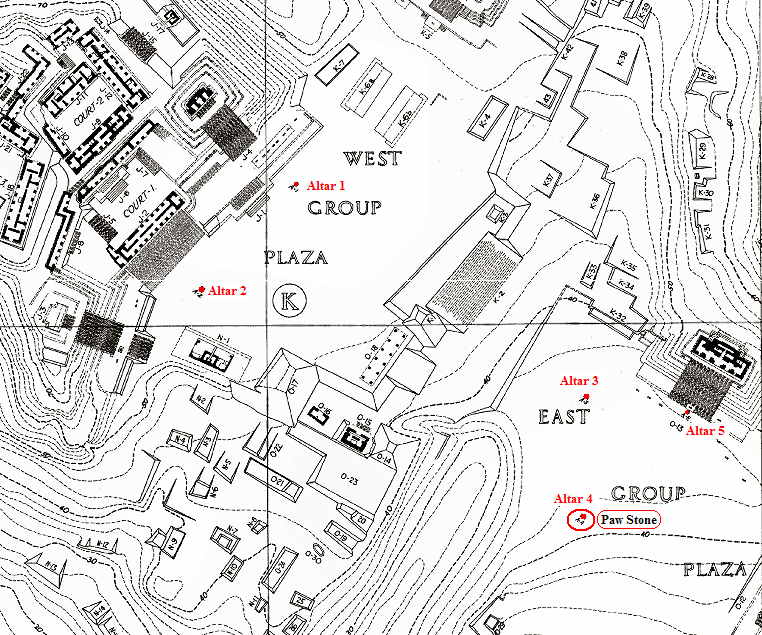
From this map we can clearly see that Altars 3 and 4 (Altar 4 is also referred to as the Paw Stone) can be eliminated because they are sitting in the middle of a plaza and are not "set in front" of
Altar 5 is one of the two round table top altars and was apparently found by the UPenn team laying "broken in pieces" at the bottom of the stairway of Structure O-13. There is very little information on this altar, but we know from Morley's The Inscriptions of Peten that it had no markings on it anywhere.4 This would seem to preclude it from being an emblem candidate as we should be able to count the number of facets that were on the crystal. It did lie directly behind Stela 14 which is also at the bottom of the staircase of Structure O-13 and this stela was removed and taken to UPenn. However, this object was removed from PN in 1931 and therefore could not have still been there in 1934 when reading 440-12 was given.
Altar 2 is a square table top altar which has a triple row of inscriptions carved on all its sides. It does appear to be well-positioned in front of the J-2 stairway leading up to Court 1 which in turn, leads to Structure J-6 which houses one of the more important items discovered at PN, Throne 1. Being a square altar though, makes it a "tough sell" as an emblem of a firestone that was described as cylindrical. It also is devoid of markings on its face.
Altar 1 is a round table-top altar and also sits in the outer court in front of the J group of structures, collectively known as the Acropolis. As noted by Van Auken and Little in The Lost Hall of Records, Altar One is reminiscent of the Aztec calendar stone which is often referred to as a sundial.6 It has two concentric rows of hieroglyphs on its face that are carved in a circle surrounding a carving that shows two seated figures facing each other:
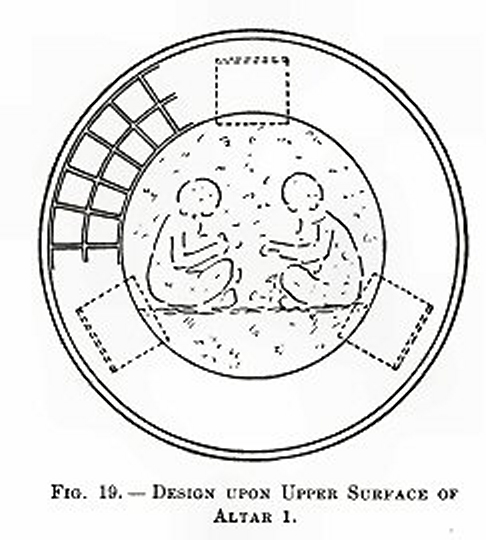
When describing Altar 1 in his monumental, encyclopedic, 5 volume book, The Inscriptions of Peten, Sylvanus Morley wrote,
The top of the slab was sculptured with two concentric rows of glyphs around its outer edge. If Maler's drawing is to scale, there would seem to have been 33 glyphs in each row, or 66 in all.7
Could the two concentric rows of hieroglyphs in a circle on the face of Altar 1 be construed as a representation of the crystal facets? When reading the description of the Great Crystal in reading 440-5 it states that,
....we find it was a large cylindrical glass (as would be termed today), cut with facets in such a manner that the capstone on top of same, made for the centralizing of the power or force, that concentrated between the end of the cylinder and the capstone itself....
While it is impossible to determine if the above excerpt is describing facets that were actually cut on the "capstone on top of same" or were cut in other parts of the crystal to create the effect that "...made for the centralizing of the power or force...". Either way, the possibility exists that there may have been facets cut on the capstone itself and, if so, Altar 1, could be representing this. This altar still lies at Piedras Negras in pieces.
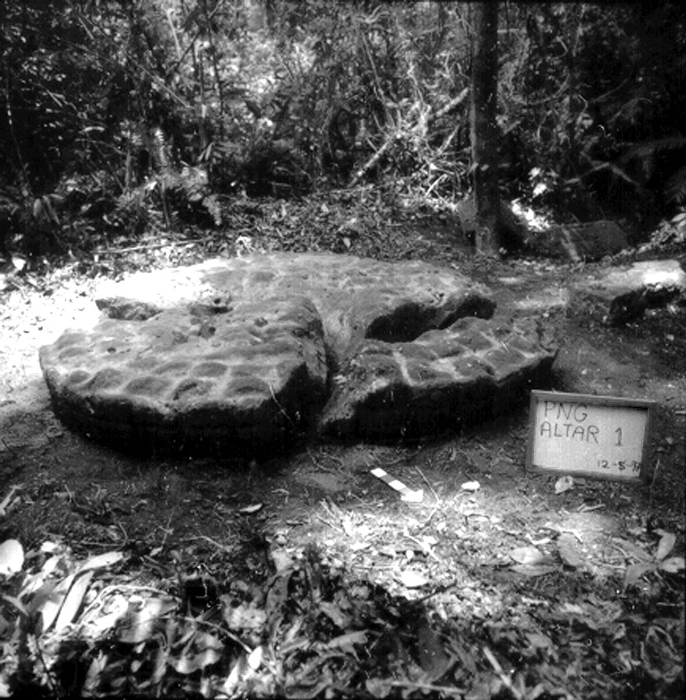
Since this altar is still lying at Piedras Negras it would seem to be eliminated as a possible firestone emblem because a portion was never moved to UPenn. However, in the 1935 National Geographic article about the UPenn expeditions by expedition director J. Alden Mason, he shows a photograph of some workers that were trying to drag this huge 7 foot diameter Altar One by rope.8 The interesting part of this photo is the caption underneath. The photo
A MASSIVE ROUND ALTAR BEGINS ITS JOURNEY TO A MUSEUM
Although this altar has not been exported it was moved with that intention. A gang of men pulled it into a clearing to prepare it for transport....
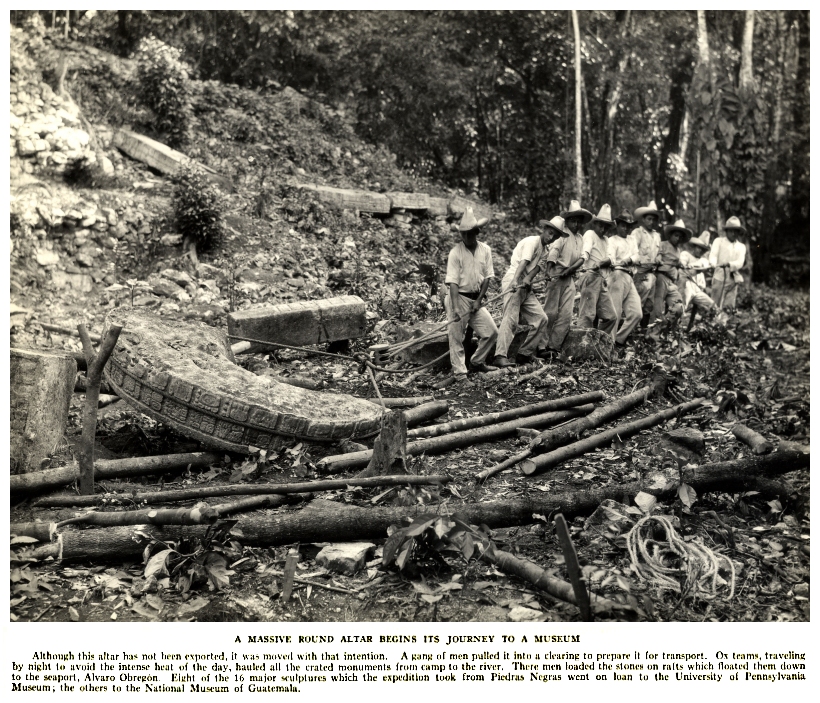
Did the source Cayce channeled in readings 440-5 and 440-12 pick up on the obvious desire of Mason to bring this altar back to Pennsylvania? If you look at the way they are trying to move the altar is
Rather sufficient would it be that there be particular precaution in the uncovering of the stone...
As pointed out previously, "uncovering" does not necessarily mean digging out of the ground, but could mean
...recovering and restoration in part (for the better comprehension of that which took place) in Yucatán...
Why this altar was never actually transported is not explained in the article. The important point is that they were attempting to do so and it's possible that Cayce picked up on this in December 1933 (440-5):
....A portion is to be carried, as we find, to the Pennsylvania State Museum....
I also believe it is significant that this desire to transport Altar One was still alive in 1935, when the National Geographic article was published, (the photo was apparently taken in 1931), otherwise, why include it in the article? As explained earlier, the earliest any object or emblem could have arrived in Pennsylvania was 1935.
Also note that the 440-12 quote includes the phrase "though erosion has had an effect upon same". This fits in nicely with the fact that the carving of the two figures on the altar top is indeed eroded to the point that you cannot exactly make out what the two seated figures are doing (unfortunately the hieroglyphics carved on the top are also too eroded to read). The use of the term "erosion" in 440-12 would also indicate that the object was not buried but exposed to the elements:
...For this is the place, IS the stone - though erosion has made an effect upon same...
Is Altar One Positioned as the Laver?
So far we have determined that Altar 1 is a round altar that looks somewhat like a sundial, and could possibly have a representation of the number of facets carved on its top or face. But is it positioned properly as the "altar that stood before the door of the tabernacle"? At first glance, looking at the map above, it would appear that it is not as well-positioned as Altar 2. However this map is an overview of part of PN and the heights of the various structures cannot be easily ascertained.
First of all, Altar 1 sits directly in front of a row of eight huge stelae that rest on a terrace that leads directly to a stairway which is actually the side of one of the largest pyramids in the entire PN site, J-4. A drawing by Maler from his Peabody Museum Memoirs Volume II, gives a clearer picture of where it is positioned: 9
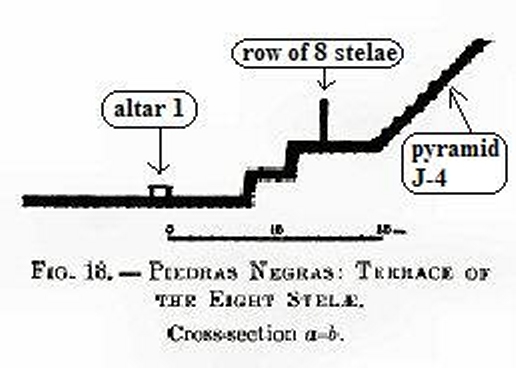
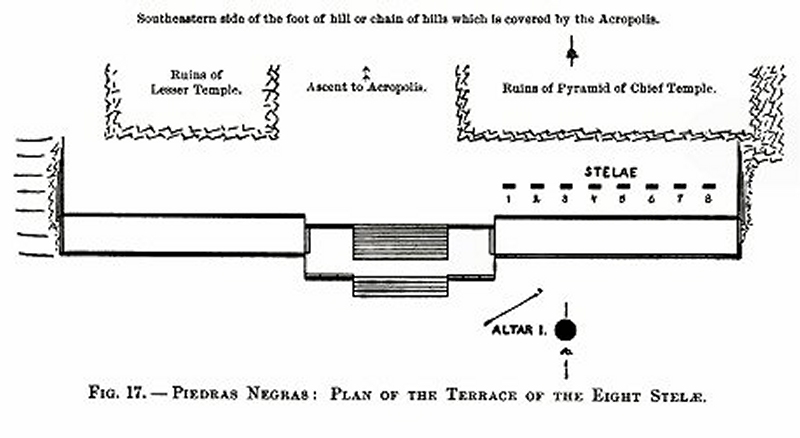
From these two drawings we can see clearly, that Altar 1 is well-positioned as the laver, the altar before the tabernacle door, directly in front of the large J-4 Pyramid, the most imposing structure on the Acropolis.
Does Altar One Face an Opposite Chamber?
....of what might be termed the sun dial that lies between the temple and the chambers, or OPPOSITE temple - where sacrifices were made.....
From the map showing the 5 table-top altars above, it appears that there is no "opposite" temple or chamber in the West Group Plaza that would fulfill the above reading excerpt from reading 440-12. However, from the UPenn paper, Piedras Negras Archaeology, 1931-1939, we find the following description of Pyramid O-12:
From P-1 we may conveniently go around to the front of Pyramid O-12. This conforms to the general type, having had a single front stairway leading to a broad terrace at the base. In this case there are two terraces, one lower and in front of the other, obviously an adaptation to the terrain, which slopes from the pyramid's left to its right. Both terraces run parallel to the front of the pyramid. The front slope was cleared considerably in a search for lintels, which were not found. The lowest steps were intact in some places, with hard plaster on the adjacent portions of the upper of the two terraces. The inside of the temple was cleared, revealing a single room temple with three front doorways. A narrow sill, hardly a bench, ran along the rear wall on the inside. The width of the room, including this sill, was 1.8 m. Walls varied from 1.1 m (front) to 1.5 m (rear) in thickness. The roof was probably a stone vault, though the evidence for this fact was not recorded.
The temple floor is 17 m above the level portion of the plaza in front of Structure O-13. At this height it commanded an excellent view over the East and West Group Plazas to the Acropolis, which it in general faces.10
Expanding the above map to include both the East and West Group Plazas (below), we find that through the connection of the K-2 stairway, that Pyramid O-12 does indeed face its opposite, Pyramid J-4.11 There does not seem to be any intervening structures between the two buildings, so you could say that Altar 1 lies "between" the two, although certainly it is not halfway between them as you would commonly visualize them in your mind when reading this excerpt from 440-12.
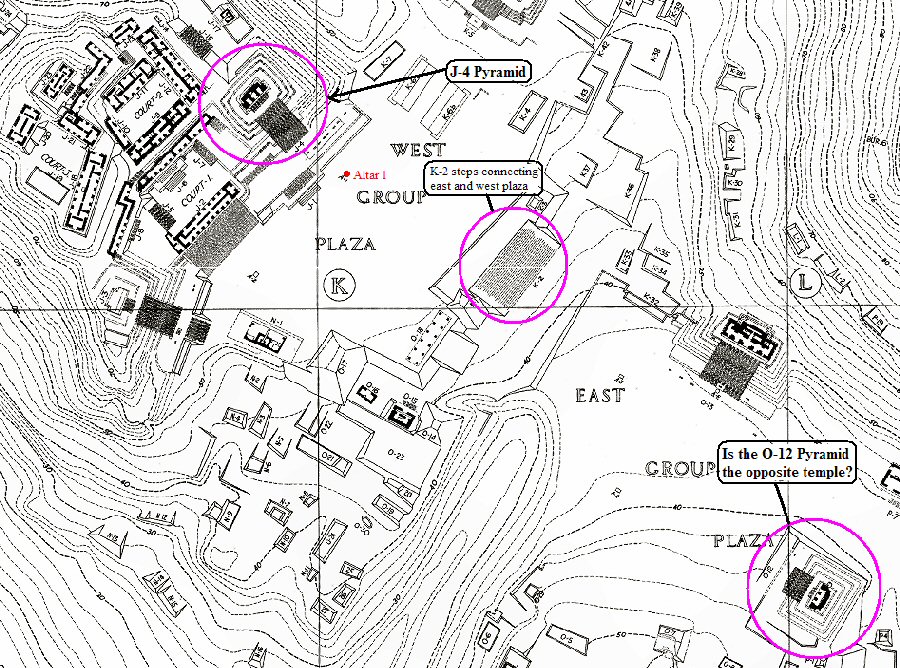
Long Count Dates
Another point in favor of Altar One being the firestone emblem is the fact that some of the dates carved on this stone were interpreted by Sylvanus Morley, as preceding the beginning of the Mayan Long Count of 3114BC. As noted in The Lost Hall of Records, Morley devoted over nine pages of his book on the Altar One dates, with dates as early as 4000BC and 5000BC being found on this stone.12 While his findings caused great controversy and were disputed by many, his interpretations should not be dismissed out of hand. As noted by J. Eric Thompson in his introduction to Morley's book, An Introduction to the Study of Maya Hieroglyphics, Morley was the expert in his field of Mayan
Morley was not an intellectual. He was content to amass data, but showed little interest in using them to interpret Maya civilization. His energies were directed to deciphering the calendrical dates--his ability to wrest a date from a badly weathered stela was phenomenonal--but his concern for noncalendrical glyphs was so small that usually he did not trouble to draw them.
The results of his many years of exploration were published in The Inscriptions at Copan, already mentioned, and The Inscriptions of Peten, 1937-38, comprising four volumes of text, one of plates and another of maps. In this encyclopedia, every known date in that region is discussed in detail and there are descriptions and plans of each site.13
Morley's discussion of Altar 1 is extensive and intricate, especially when you're not familiar with how the Mayan's counted time, as I most certainly am not. However, that aside, it is interesting to note some of the general observations made by him,
Before beginning the decipherment of the several dates recorded in Altar 1, it should be pointed out that all of them save four were in the very remote past even at the time they were inscribed. Five of them are from nine to sixteen centuries earlier than the beginning of Maya chronology, i.e. 4 Ahau 8 Cumhu, end of Baktun 13, which latter date itself preceded the probable contemporaneous date of Altar 1 (10.0.0.0.0) by another four millennia. Indeed, between the extreme dates on Altar 1 there is the tremendous total of 6004 years. It is obvious that when dates in such a remote past are recorded they must refer to astronomic events or calendric calculations and that they are not historical in the usual sense of the word.14
While it is easy to dismiss these dates as "not historical", much of that may depend on your own personal view of what happened in our remote past.
Summary
All of the previous points discussed throughout this article, point to the fact that an important stone at Piedras Negras, Altar 1, could be the firestone emblem alluded to in Cayce reading 440-5.
Altar 1 looks like a sun dial, and is located in the same position the laver was, in front of the tabernacle door. It is in front of one of the most important temples at Piedras Negras, the J-4 Pyramid of the Acropolis. Altar 1 also lies between the two opposite facing pyramids J-4 and O-12.
Altar 1 has a double row of concentric hieroglyphs (33 in each row, 66 total) carved in a circle on its top that could represent the facets cut into the firestone crystal.
This altar was supposed to be taken back to the University of Pennsylvania Museum in 1931 but, although an attempt was made to move it for export, for some unknown reason this was not carried out. There still, however, may have been some discussion among the UPenn researchers as to how to get Altar 1 back to Philadelphia after this failed attempt and the source channeled by Cayce may have picked up on this.
Altar One also contains some of the oldest dates found at PN, spanning over 6000 years, many of which precede the start of the Long Count of 3114BC. This gives added weight to the possibility that Altar 1 may have been of ancient origin or at least represented something of ancient origin. Add to this, the fact that no artifact actually brought back to UPenn fits all of the criteria that was laid out in the two readings that deal with the emblem, and you are left with the strong possibility that Altar One was the firestone emblem.
Acknowledgments
I would like to thank Jonathan Eagle for his uncanny ability to point out areas in this article that needed improvement and always challenging me about my assertions. Also, for his talent in making the article look terrific. A very special thanks goes to William Hutton whose unending patience, encouragement and support gave me the desire to pursue this subject to its conclusion.
- John Van Auken and Lora Little, The Lost Hall of Records (Memphis: Eagle Wing Books, 2000), p. 84
- J. Alden Mason, "Preserving Ancient America's Finest Sculptures," National Geographic Magazine, LXVIII, No. 5, (1935), 569.
- Linton Satterthwaite, Jr., Mary Butler, and J. Alden Mason, "Piedras Negras Preliminary Papers," Piedras Negras Archaeology 1931-1939, (2005), 12-13.
- Sylvanus Griswold Morley, The Inscriptions of Peten, Volume III (Washington: Carnegie Institute of Washington, 1937), p. 25.
- Teobert Maler, "Researches in the Central Portion of the Usumatsintla Valley," Memoirs of the Peabody Museum, Harvard University, II, No. 1, (1901), 54.
- ibid. p. 45.
- Morley, op. cit., p. 285.
- Mason, op. cit., p. 545.
- Maler, op. cit., p. 44-45.
- Satterthwaite et al., op. cit., p. 22.
- ibid., p. 12-13.
- Van Auken and Little, op. cit., p. 133.
- Sylvanus Griswold Morley, An Introduction to the Study of the Maya Hieroglyphs (New York: Dover Publications, 1975), p. xi.
- Morley, op. cit., p. 286.

